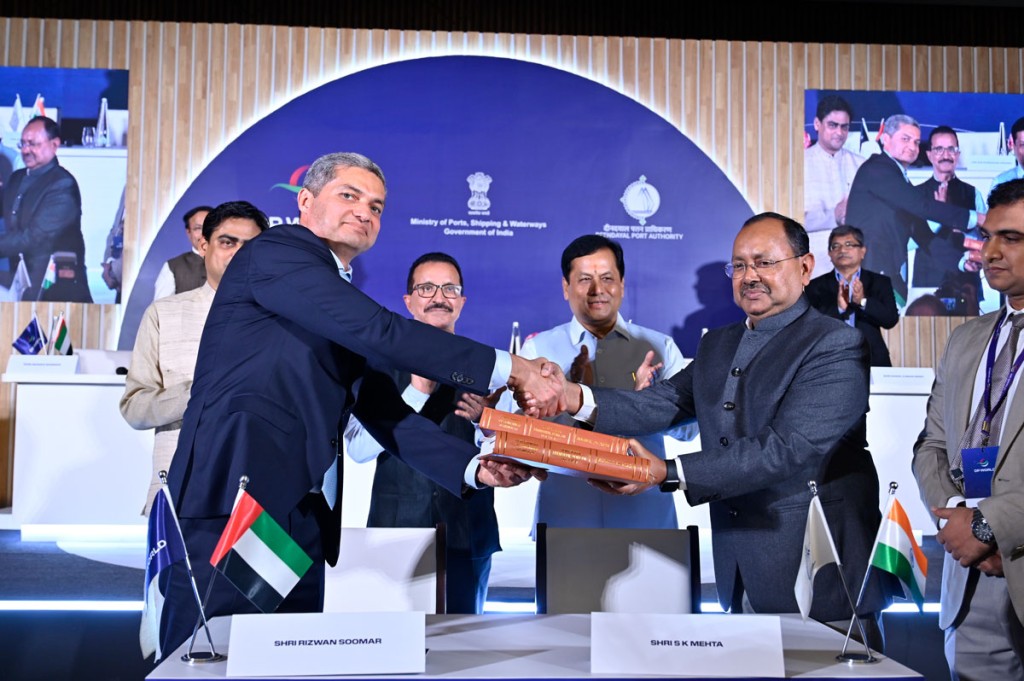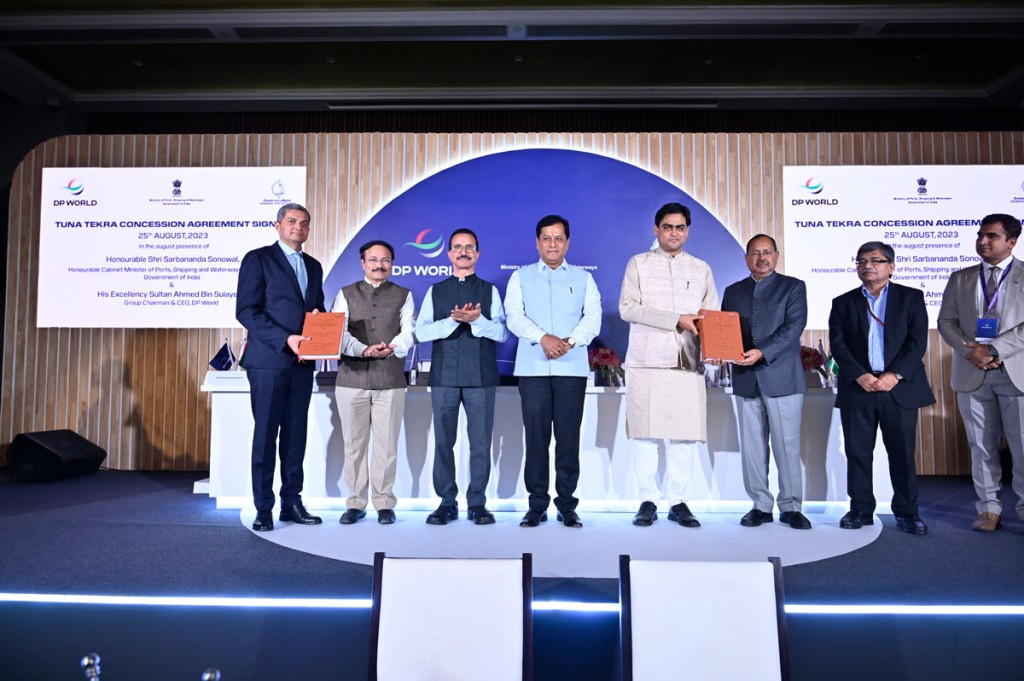DP World’s increased involvement in India’s port infrastructure development expected

Indian shipping experts, closely monitoring Dubai-based DP World’s engagement, expect the latter to get further involved in India’s expanding port infrastructure following its recent concession agreement with the Deendayal Port Authority (DPA) – also known as Kandla Port - to invest US$ 510 million to build and develop a new 2.19 million TEU per annum mega-container terminal at Kandla in India’s western state Gujarat.
The concession agreement was signed in August 2023 between S.K. Mehta, the DPA chairman, and Rizwan Soomar, DP World’s CEO/Managing Director (India Subcontinent, Middle East, and North Africa); DPA had awarded the concession for the project earlier this year to Hindustan Infralog Private Ltd, a joint venture between DP World and India’s investment platform National Investment and Infrastructure Fund.
The mega-container terminal project, which will have a public-private partnership, will be on a build-operate-transfer (BOT) basis for a period of 30 years with the option to extend it by another 20 years and will be at Tuna Tekra near the Deendayal Port, Kandla.

Port experts say that on its completion in 2027, the terminal will be supported by state-of-the-art equipment and a 1,100 m berth capable of handling next-generation ships with a capacity exceeding 18,000 TEUs.
The new mega-container terminal will be linked to the hinterland through a network of roads, highways, railways, and Dedicated Freight Corridors, supporting the growing demand for logistics solutions from across Northern, Western, and Central India, connecting businesses in these regions with global markets.
DP World is deeply involved in the Indian subcontinent’s port development: it already operates five container terminals – two in Mumbai, one each in Mundra, Cochin, and Chennai, with a combined capacity of some 6 million TEUs; this combined capacity would further increase to 8.19 million TEU on Tuna Tekra’s completion. It is also developing three state-of-the-art economic zones in Mumbai, Cochin, and Chennai.
Sarbananda Sonowal, India’s Minister for Ports, Shipping & Waterways, recently hailed the signing of the DP World’s concession agreement as a “momentous event”, marking “another significant breakthrough in building the best-in-class infrastructure in India under the public-private partnership”.
The DPA chairman S.K. Mehta said that the Tuna Tekra mega-terminal would be one of the nation’s largest container terminals and would help increase productivity and the port’s cargo handling capacity.
Port Expansion Expected to Open up Trade Opportunities for Indian States
DP World says that the mega-container terminal will provide various Indian states greater access to world markets. “This project will enable DP World to deliver trade opportunities, by connecting Northern, Western and Central India with global markets, thereby driving value for all our stakeholders. India represents a significant landscape for opportunity,” observed Sultan Ahmed bin Sulayem, DP World’s chairman and CEO.
Rajiv Dhar, the CEO/Managing Director, National Investment, and Infrastructure Fund, described the project as a “testament to our ability” to drive large-scale infrastructure development by partnering with strategic players.
Indian shipping experts say that the terminal will boost India’s container traffic growth and through its external connectivity can also greatly enhance trade with various landlocked regions, reducing logistics costs and increasing the efficacy of supply chains. According to Indian sources, the project will complement the Indian Government’s initiatives, including the Gati Shakti Master Plan and National Logistics Policy on developing multimodal logistics infrastructure and boosting economic growth.
Indian sources further argue that DP World’s investments in India’s ports and terminals are aligned with New Delhi’s Vision 2047 aimed at quadrupling the country’s port-handling capacity.
Kandla Port, which has played a pivotal role in India’s external trade, also has an adjacent Kandla Special Economic Zone (KASEZ), the first special economic zone to be established in India and, indeed, in Asia. Over the years, the port has evolved into the nation’s hub for exporting grains and importing oil and other products, becoming one of India’s highest-earning ports.
Kandla, along with two other ports, Paradip and Tuticorn, will be developed into so-called “Green Hydrogen” hubs, according to an initiative of India’s Ministry of Ports, Shipping and Waterways; they will serve the hydrogen export sector. The government has plans to develop the necessary infrastructure within these ports to support all activities such as production, storage, handling and bunkering of green hydrogen. These hubs are being designed to complement India’s efforts to penetrate the international green energy market.
Kandla to be Part of Intercontinental Economic Corridor
Kandla and three other west coast ports Jawaharlal Nehru Port (JNP), Vadhawan and Mundra, are reportedly expected to be part of the ambitious India-Middle East-Europe Economic Corridor (IMEEC).
According to shipping circles in Gujarat, the government has drawn up plans to groom the three major ports to become a crucial part of the transnational rail and shipping corridor that will boost trade and connectivity across Asia, the Gulf States and Europe. The Tuna Terka container terminal at Kandla and JNP’s expansion are part of the master plan to develop them as a key hub for international trade, particularly through the IMEEC.
A memorandum of understanding on IMEEC’s creation was signed between Saudi Arabia, the European Union, India, the UAE, France, Germany, Italy, and the U.S. on the sidelines of the recent G-20 summit meeting in New Delhi; more concrete details about the project are expected to be announced at a follow-up meeting in November 2023.
DP World Opens Warehouse Near Mumbai
As part of its investment in India’s inland logistics, DP World opened a warehouse in Bhiwandi on the outskirts of Mumbai.
“This new facility elevates DP World’s warehousing capability to 5+ million sq. ft. of warehousing space pan India,” the company said in a statement. The facility, about 380,000-sq. ft., has the necessary infrastructure to store hazardous cargo and temperature-controlled goods.
“A partition divides the entire warehouse into two sections – one spans 190,000 sq. ft. and is specially designed for hazardous chemical storage, complete with heavy-duty G+8 level racking and state-of-the-art very early smoke detection apparatus (VESDA),” DP World said.
The company further noted: “The second section covers 150,000 sq. ft. and is dedicated to non-chemical storage. Additionally, the warehouse includes a 40,000 sq. ft. separate area featuring two distinct cold storage rooms.”
According to DP World, the additional warehouse in Bhiwandi would support its strong infrastructure position in India and enable the company to assist customers by offering enhanced connectivity between the global and domestic markets.
Spurred by DP World’s thrust, other companies are also strengthening their presence in India, impressed by the country’s projected economic growth rates of between 7 and 8% in the coming years, along with expected strong growth in its foreign trade.
A.P. Moller-Maersk, for instance, has been scouting for investment opportunities in the country and also adding new warehouse facilities to its operations across the country.
© Copyright 1999–2024 American Journal of Transportation. All Rights Reserved

